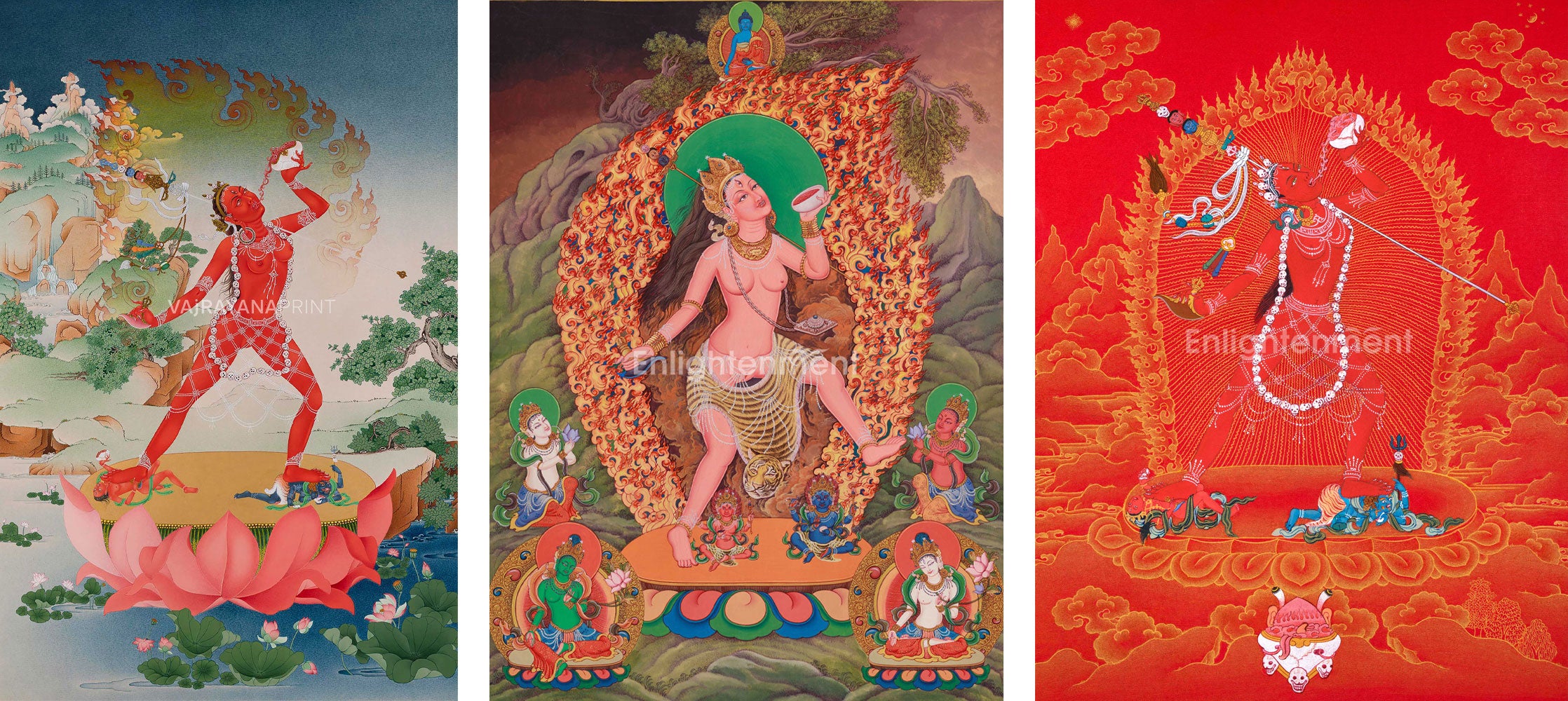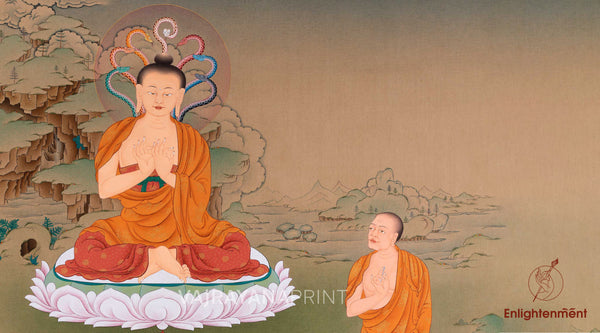Awakening the Inner Goddess: The Power of Red Dakini Vajrayogini
Within Vajrayana Buddhism, Red Dakini Vajrayogini is revered as embodying profound teachings and practices. Her essence leads practitioners to enlightenment by embodying the transformational force of knowledge and compassion.
Key Takeaways:
- Vajrayogini represents the embodiment of enlightened wisdom and compassion.
- She is a central figure in Vajrayana Buddhism, particularly within the Tibetan Buddhist tradition.
- Vajrayogini's practices are aimed at attaining spiritual realization and liberation.
- Her symbolism encompasses transformation, passion, and the journey towards enlightenment.
Origins and Mythology
Click here to view our Vajrayogini Statue
The roots of Vajrayogini may be found in the tantric traditions of ancient India, namely in the Chakrasamvara Tantra, where she is considered the consort of the tantric deity Chakrasamvara, who represents enlightened consciousness. She became increasingly well-known across many Buddhist lineages, particularly in Tibet, where she played a crucial role in Vajrayana rituals.
Mythological Narrative
Buddhist legend states that Vajrayogini manifested the Buddha's wisdom that sprang from his heart. She represents the transforming force that leads to enlightenment and the combination of knowledge and technique. According to legend, she takes on a furious shape to defeat evil spirits and impediments to waking.
Sky-Dancer Tantra
Click here to view our Vajrayogini Thangka
Goddess Vajrayogini is often called the "Sky-Dancer," a being that dances across the sky of ultimate truth, unencumbered by the limitations of everyday life. Through her practice, practitioners learn to see the universe as a divine drama and to see that the apparent separateness and solidity of events are illusions.
This insight enables practitioners to live without the dualities and attachments that define everyday existence and to move through life with the joy and freedom of a sky-dancer.
The Sky-Dancer Tantra highlights reality's non-dual character. It views the divisions between self and other, samsara and nirvana, as conceptual impositions on reality's actual nature, which is bright in its expression but devoid of essential existence.
Direct Realization of Emptiness
The direct realization of emptiness (Shunyata), the ultimate essence of all things, is at the core of Vajrayogini's teachings. This insight is a direct, non-conceptual awareness of the emptiness of intrinsic existence in everything, including the self. It is not an intellectual comprehension.
By directing the energy of change and desire towards the awareness of emptiness, the practice of Vajrayogini helps practitioners break free from the cycle of samsara.
This part of her teachings pushes followers to face and overcome their most attachments and dislikes, seeing them for what they are, symptomatic of a lack of understanding about the fundamental nature of reality. Through emptiness meditation, practitioners can destroy the impediments preventing them from experiencing enlightenment.
Guru Yoga
An integral part of Vajrayogini's practice is Guru Yoga, which emphasizes the significance of the guru-disciple bond. In Vajrayana Buddhism, the guru is regarded as the direct conduit for spiritual transmission and enlightenment and as the incarnation of all Buddhas.
Practitioners who devote themselves to the guru receive blessings, lessons, and empowerment, all essential for advancing. In the practice of Vajrayogini, the guru is frequently seen as united with Vajrayogini, signifying the non-duality of the teacher's wisdom and the transformational power of the dakini.
Through this practice, practitioners can fully embody the teachings and attributes of Vajrayogini and develop a profound connection to the lineage of teachers and the stream of blessings and knowledge that flows from them.
Mantra of Vajrayogini
"Om Om Om Sarva Buddha Dakiniye Benza Wārṇāṇiye Benza Bairotsaniye Hung Hung Hung Phat Phat Phat Soha"
- Om Om Om: By repeating the primal sound Om, one can connect with the enlightened energy of the cosmos and summon the blessings of the three jewels, Buddha, Dharma, and Sangha.
- Sattva Buddha denotes enlightened creatures, Dakiniye denotes feminine energy or wisdom consorts, and Sarva means all. This portion of the mantra calls for the practitioner's protection and guidance on the path to enlightenment and the presence and blessings of all enlightened Dakinis, especially Vajrayogini.
- Benza Wārṇāṇiye: Benza (Vajra) signifies unbreakable wisdom, and Wārṇāṇiye is a term for the color yellow, which stands for the luminosity and brilliance of enlightened understanding.
- Benza Bairotsaniye: Benza (Vajra) is unbreakable knowledge, and Bairotsaniye is red, representing the ferocious and vindictive side of enlightened compassion.
- Hung Hung Hung: These sounds are known as bija (seed) mantras, and they stand for removing barriers and awakening enlightened energy. Hung is linked to the Buddha's enlightened body, speech, and intellect; it is also connected to the angry side of enlightened action.
- Phat is a potent syllable to conquer negativity, barriers, and delusions. Its recurrence clears the mind and makes the atmosphere suitable for spiritual practice.
- Finally, the mantra Soha is spoken to seal the practice and devote the merit created by the recital of this mantra to the benefit of all sentient beings. It means presenting the blessings of the mantra to all enlightened beings and creatures across the universe.
Benefits of Chanting the Mantra:
- Invocation of Dakini knowledge: By calling upon the blessings of enlightened Dakinis, like Vajrayogini, the chant bestows upon practitioners protection, knowledge, and direction in their journey toward enlightenment.
- Body, Speech, and Mind Purification: Reciting the mantra helps the practitioner rid their body, speech, and mind of any negativity or obscurations that impede their spiritual development.
- Enlightened Energy Activation: Reciting the mantra awakens the practitioner's inner compassion and knowledge by igniting the latent energy of enlightenment.
- Dispelling of Obstacles: The strong vibrations of the mantra drive out impediments, lousy luck, and obstructions, fostering a favorable atmosphere for spiritual development and realization.
- Dedication of Merit: By ending the practice with the mantra "Soha," practitioners cultivate compassion and charity by dedicating the merit created by their recitation to the well-being and liberation of all sentient beings.
Symbolism and Iconography
A significant figure in Vajrayana Buddhism, particularly in Tibetan Buddhism, Vajrayogini is a female tantric deity who embodies the highest wisdom and immense happiness.
She is regarded as a Dakini, representing enlightened feminine energy in Tantric traditions. The imagery of Vajrayogini is full of qualities and symbols that convey her spiritual importance and abilities. Here is a detailed examination of her appearance and symbolism:
Physical Appearance
- Form: Vajrayogini, the embodiment of ultimate happiness and wisdom, usually takes on a young appearance. Her ferocious and alluring beauty symbolizes her control over life's dualities (e.g., life and death, spiritual and ordinary).
- Color: She is frequently shown with a crimson body, signifying her mastery over desire and her conversion of base impulses into enlightened understanding.
- Facial Expression: Her expression is typically one of fury, and the three eyes on her face stand for her capacity to look into the past, present, and future. Her angry countenance deters malevolence, and her third eye represents the insight transcending dualism.
Iconographic Attributes

- Fire Halo (Aura): She is frequently shown with an aura or fiery halo surrounding her, signifying her ability to change and burn away her ego and ignorance.
- Crown of Skulls: Vajrayogini's crown has five skulls, which represent the five kleshas, or negative mental states: ignorance, attachment, aversion, pride, and jealousy. These states are transformed into the five wisdoms.
- Skull Cup with Chopper in Hand: She is holding a chopper, or curved knife, in her right hand, representing slicing through illusions and barriers. Symbolizing the conversion of bad traits into good, enlightened insight, she holds a skull cup in her left hand that is filled with blood, or amrita, the elixir of immortality.
- Standing Position: She is frequently seen dancing over a human corpse, signifying the triumph of ignorance and vanity. The dance represents her active participation in the world and the delight of living an enlightened life.
- Necklace of Severed Heads: The Vajrayogini is occasionally shown wearing a necklace made up of fifty recently severed human heads, each of which stands for one of the Sanskrit alphabet's fifty letters, signifying the power of speech and mantra mastery.
- Khatvanga: She may be holding a khatvanga, a ceremonial staff, or it may be lying on her shoulder, signifying the union of masculine and female principles or her partner. The three heads at the top of a khatvanga are commonly associated with the three kayas (bodies) of a Buddha, namely the Dharmakaya, Sambhogakaya, and Nirmanakaya.
- Nakedness: Her lack of clothing represents liberation from the illusion of duality and traditional reality. It stands for the objective, unadulterated truth of things as they indeed are.
Practices and Rituals
- Sadhana Practice
Sadhana, a spiritual practice that includes mantra recitation, visualization, and meditation on Vajrayogini's form, is essential to her devotion. Practitioners perform complex rites to call upon her graces and invite her presence. Offerings, prayers, and visualization techniques are commonly used in sadhana to enlighten the mind and awaken to one's true Buddha-nature.
- Strengthening and Prompting
An authorized teacher must bestow empowerment and initiation before one may partake in Vajrayogini's activities. These empowerments are essential for developing a direct relationship with god and getting the benefits of spiritual advancement. Detailed directions on how to carry out the sadhana and apply Vajrayogini's teachings to everyday life are provided to initiates.
- Retreats, as well as Intense Exercises
Expert practitioners frequently participate in retreats devoted to Vajrayogini, spending extended time fully submerged in her practices. These retreats, designed to help participants become more aware of their enlightened nature, include intense meditation, mantra recitation, and ceremonial offerings. Retreatants may meditate alone for weeks or even months, concentrating only on the teachings and blessings of Vajrayogini.
Amidst the immense ocean of Buddhist teachings, Vajrayogini shines as a light of compassion and wisdom. Her presence, which is both strong and sympathetic, serves as a reminder of the capacity for transformation everyone possesses. By practicing diligently and with unshakable commitment, practitioners can discover the mysteries of enlightenment and feel the limitless bliss of freedom.



1 comment
ananda cory
I have worked with this practice for years and hit wormy poop